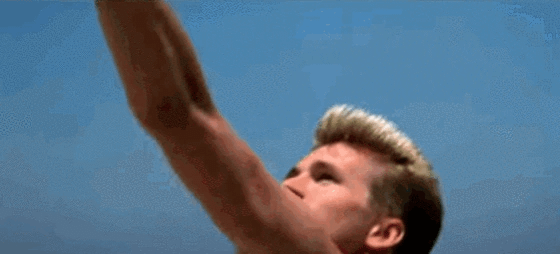Imagine a volleyball tied to a rope. This rope is then tied to the top of a pole, so the volleyball can hang down by the side of the pole.
Two opposing players then try to smack or slap the ball so that it goes around the pole, and the first person to wrap the rope all the way around the pole wins the game.
This game is called tetherball.
During middle school recesses, one of the things I would do (when I wasn’t busy sneaking off to play tackle football) was to play tetherball. This game fascinated me for a number of reasons, not the least of which were geometry-based.
Sure, if one kid was much bigger than another, they had a huge intrinsic advantage. And yet, I saw this physical advantage overcome time and time again with superior thinking—especially the ability to predict the arc the ball would take when it was hit.
If you zoom out a bit, this apparatus is a great tool for thinking about math. The tethered rope creates a radius, and that sphere (with the top of the pole at the center) represents the total range of the tetherball—there’s no way to hit the ball and get it to go anywhere outside of this sphere.
If you wanted the ball to zoom over someone’s head, higher than they could hope to hit it back, you would need to hit the ball downward instead. This made me a bit more comfortable with using inversion to solve problems, something we were just now starting to get into on paper with algebra.
Here was a tangible, real-world example of spherical geometry, inversion, and a way to think in terms of angles. This was such a great way for kids to learn geometry.
Even better, it was a psychological game. You could get kids to think you were going one way, then get them to react in a way that leaves them open. There was a certain advantage to serving the ball by striking it downward so that it would go over your opponent’s head on the other side, but one game was to hit the ball upward instead—if the person was expecting something up high, you could sometimes go low and surprise them.
When I was eleven or thereabouts, tetherball was the ideal activity for my brain and body to work together, and I played it a lot. It was overall a pretty safe game, with relatively fewer injuries than team-based ball sports. However, that doesn’t mean I didn’t get to see at least one doozy of an injury.
One day, a kid named Ollie was playing tetherball. Ollie was very good at tetherball, and I’d see him up there on the playground nearly every day. He liked to return the ball with the inside of his forearm—the side his thumb was on, I mean. Think Top Gun volleyball, but with one arm instead of two.
On this particular day, the safety flaw in this Ollie’s strategy was revealed. As he went to return the ball, his thumb was jutting out from the side of his fist, not tucked in front, as when you throw a punch:
The Anatomy of Impact
Tiny clubs are being thrust at someone’s head over and over again. Someone is holding a few small wooden dowel rods in their hand, and stabbing at their head with the tips of these little rods.
When the tetherball (leather, not soft) hit his protruding thumb, it struck the nail at an oblique angle. Ollie crumpled in a mess on the ground, holding onto his thumb. When we could finally get a look at it, it was evident that the nail had been split right in half, all the way down to the quick.
I was horrified in a way I probably hadn’t been since that time I watched Chad take a bad hop, but I didn’t quit playing tetherball: I just made doubly sure that my thumb was always tucked in. When I learned how to throw a proper punch, years later, I at least already had this idea down.
I’m grateful to tetherball for these reasons. I’m a slightly better martial artist for having learned to keep my thumb safe early on, I learned physical geometry by doing, and I got to practice one-on-one psychological warfare, in a manner of speaking.
Thank you, tetherball!








I played my fair share of tetherball in elementary school. Although my all time favorite was four square. Any good analysis (or stories) for that game?
It hurt a *lot* if you hit the top of the ball where the rope tied onto the ball. I was pretty good, hell i was GREAT!!
That's what I remember